I want to add on this plot the weekday as text on top of the bars. The only function to add text in ggplot I found, is "annotate", which does not work the way I want.
It should look like this:
geom_text gives me this Geom_text
My code:
ggplot(data = filter(T2G2_dayav, site %in% c("S17S", "S17N"), !is.na(distance)),
mapping = aes(as.factor(x = date_days))) +
geom_col(mapping = aes(y = T2pn_av, fill = as.factor(distance)),
position = position_dodge(width = 0.9)) +
theme_bw() + ylab("Particle Number (#/cm³), day-av") + xlab("Date") +
scale_y_continuous(limits = c(0, 30000)) +
scale_fill_discrete(name = "T2, Distance from road (m)") +
scale_color_grey(name = "Reference intrument G2") +
ggtitle("Day-averaged Particle Number (PN) per distance")
the head of my data:
distance date_days site T2pn_av T2pn_avambient T2wdir_med weekday Date G2pn_av G2pn_min G2pn_max G2ws_av G2ws_min G2ws_max G2wdir_med
<int> <dttm> <chr> <dbl> <dbl> <dbl> <chr> <dttm> <dbl> <dbl> <dbl> <dbl> <dbl> <dbl> <dbl>
1 -10 2017-07-18 S17N 28814.83 16917.831 110 Di 2017-07-18 13655.29 4621 105100 0.6781284 0 3.6 51.0
2 -10 2017-07-19 S17N 24210.95 15565.951 100 Mi 2017-07-19 10627.73 2908 67250 1.3673618 0 5.5 70.0
3 -10 2017-07-24 S17N 16143.44 7907.442 80 Mo 2017-07-24 11686.54 3582 55080 0.8178753 0 4.8 95.5
4 -10 2017-07-29 S17N 11762.56 5574.563 270 Sa 2017-07-29 12180.73 5413 45490 1.0304985 0 5.7 265.0
5 -10 2017-07-30 S17N 12138.22 6360.225 290 So 2017-07-30 10404.75 6113 23860 1.2385791 0 6.6 274.0
6 -10 2017-07-31 S17N 13815.32 9008.320 270 Mo 2017-07-31 11849.89 4595 46270 0.8554044 0 4.4 230.0
dput(head(T2G2_dayav))
structure(list(distance = c(-10L, -10L, -10L, -10L, -10L, -10L
), date_days = structure(c(1500328800, 1500415200, 1500847200,
1501279200, 1501365600, 1501452000), class = c("POSIXct", "POSIXt"
), tzone = "Europe/Berlin"), site = c("S17N", "S17N", "S17N",
"S17N", "S17N", "S17N"), T2pn_av = c(28814.8306772908, 24210.9512670565,
16143.442364532, 11762.5630630631, 12138.2247114732, 13815.3198380567
), T2pn_avambient = c(16917.8306772908, 15565.9512670565, 7907.44236453202,
5574.56306306306, 6360.22471147318, 9008.31983805668), T2wdir_med = c(110,
100, 80, 270, 290, 270), weekday = c("Di", "Mi", "Mo", "Sa",
"So", "Mo"), Date = structure(c(1500328800, 1500415200, 1500847200,
1501279200, 1501365600, 1501452000), class = c("POSIXct", "POSIXt"
), tzone = "Europe/Berlin"), G2pn_av = c(13655.2885517401, 10627.7329973352,
11686.5429216867, 12180.7308516181, 10404.7472642001, 11849.8893070109
), G2pn_min = c(4621, 2908, 3582, 5413, 6113, 4595), G2pn_max = c(105100,
67250, 55080, 45490, 23860, 46270), G2ws_av = c(0.678128438241936,
1.36736183524505, 0.817875347544022, 1.0304984658137, 1.23857912107,
0.855404388351763), G2ws_min = c(0, 0, 0, 0, 0, 0), G2ws_max = c(3.6,
5.5, 4.8, 5.7, 6.6, 4.4), G2wdir_med = c(51, 70, 95.5, 265, 274,
230)), .Names = c("distance", "date_days", "site", "T2pn_av",
"T2pn_avambient", "T2wdir_med", "weekday", "Date", "G2pn_av",
"G2pn_min", "G2pn_max", "G2ws_av", "G2ws_min", "G2ws_max", "G2wdir_med"
), row.names = c(NA, -6L), class = c("grouped_df", "tbl_df",
"tbl", "data.frame"), vars = c("distance", "date_days"), drop = TRUE, indices = list(
0L, 1L, 2L, 3L, 4L, 5L), group_sizes = c(1L, 1L, 1L, 1L,
1L, 1L), biggest_group_size = 1L, labels = structure(list(distance = c(-10L,
-10L, -10L, -10L, -10L, -10L), date_days = structure(c(1500328800,
1500415200, 1500847200, 1501279200, 1501365600, 1501452000), class = c("POSIXct",
"POSIXt"), tzone = "Europe/Berlin")), row.names = c(NA, -6L), class = "data.frame", vars = c("distance",
"date_days"), drop = TRUE, .Names = c("distance", "date_days"
)))

